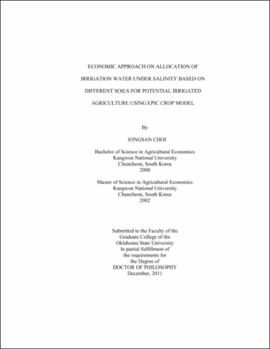| dc.contributor.advisor | Stoecker, Arthur | |
| dc.contributor.author | Choi, Jongsan | |
| dc.date.accessioned | 2013-11-26T08:21:59Z | |
| dc.date.available | 2013-11-26T08:21:59Z | |
| dc.date.issued | 2011-12 | |
| dc.identifier.uri | https://hdl.handle.net/11244/6510 | |
| dc.description.abstract | Scope and Method of Study: The objective of this study was to understand the long term effect of using irrigation water with water and soil salinity on cotton yield based on the 15 soil types along the Elm and North Fork of the Red River. The specific aims were to 1) estimate the potential cotton response for each soil type to irrigation water and salinity, 2) estimate the economic viability of establishing irrigation systems, 3) estimate dynamic soil salinity changes in response to irrigation water, the salinity of irrigation water, and the soil salinity of the previous year, 4) determine that temporal use of water with the given levels of salt concentration that maximizes the Net Present Value (NPV) of the expected utility from irrigation for each soil type. To assess the econometric relationships between cotton yield, quantity and quality of irrigation water, and soil salinity, the EPIC simulation model was used. The estimated crop yield response function, two soil salinity functions and yield variance function are incorporated in an economic decision model to find the optimal level of irrigation water maximizing NPV of the expected utility with different salt concentrations of irrigation water and three levels of risk. The dynamic optimization procedure for the economic decision model was performed by GAMS IDE. | |
| dc.description.abstract | Findings and Conclusions: The results of crop response functions for the individual soil types indicate that the cotton yield increases as irrigation water and rainfall increase, and it decreases as the amount of salts in irrigation water which is the product of irrigation and salt concentration and soil salinity increase. The soil salinity response functions at planting and harvest have a negative sign on irrigation water, growing season rainfall and non-growing season rainfall indicating the level of soil salinity decreases as the variables related with water increase. The yield variance function has a negative sign on irrigation water which is risk-reducing factor and a positive on the growing season rainfall which is risk-increasing. From the EPIC and dynamic optimization model, when irrigation water with a high salt concentration with or above 1280 p.p.m (ECw =2) is permitted from the salt control point in the study area, NPV of expected utility is negative and less than NPV of the dryland. The irrigation water containing salts should be controlled less than or equal to 1,280 p.p.m for sustainable irrigation | |
| dc.format | application/pdf | |
| dc.language | en_US | |
| dc.rights | Copyright is held by the author who has granted the Oklahoma State University Library the non-exclusive right to share this material in its institutional repository. Contact Digital Library Services at lib-dls@okstate.edu or 405-744-9161 for the permission policy on the use, reproduction or distribution of this material. | |
| dc.title | Economic approach on allocation of irrigation water under salinity based on different soils for potential irrigated agriculture using the EPIC crop model | |
| dc.contributor.committeeMember | Epplin, Francis M. | |
| dc.contributor.committeeMember | Vitale, Jeffrey Dunn | |
| dc.contributor.committeeMember | Storm, Daniel E. | |
| osu.filename | Choi_okstate_0664D_11897.pdf | |
| osu.accesstype | Open Access | |
| dc.type.genre | Dissertation | |
| dc.type.material | Text | |
| dc.subject.keywords | cotton | |
| dc.subject.keywords | economics | |
| dc.subject.keywords | epic | |
| dc.subject.keywords | irrigation | |
| dc.subject.keywords | salinity | |
| dc.subject.keywords | soils | |
| thesis.degree.discipline | Agricultural Economics | |
| thesis.degree.grantor | Oklahoma State University | |
